
10 matchstick puzzles with answers
Puzzles with matches are one of the most ancient types of logic exercises for both children and adults. The original version using bamboo sticks appeared in ancient China about 4 thousand years ago. The sense of these tasks is that you need to move one or more matches until a given condition is true. Let’s figure out the advantages of “matchstick puzzles”, what influence they have, what kinds they can be, and how to solve them.
What are matchstick puzzles good for?
Working with such puzzles develops a number of abilities such as:
Thinking
The main feature of match puzzles is that the answer is usually not obvious. Moreover, sometimes at first glance, it seems that it is impossible to get the answer at all. You usually need at least a few minutes to think or even try to solve the task with a pencil. Such exercises are surely useful for “pumping” logic and spatial thinking.
Imagination
Here, everything is obvious: figuring out what will happen if you move some of the matches, one trains the “center of imagination” in the brain.
Short-term memory
This is especially true for people who solve such tasks mentally, memorizing intermediate results.
Attention and patience
You can’t solve matchstick puzzles without focusing on them.
Decision-making ability
Here, everything is clear again as people with good logic and imagination are usually able to solve almost any problem, including non-standard ones.
Fine motor skills
This advantage is mostly important for children. Small precise movements with the use of hands and fingers develop the speech center, improve visual memory and physical coordination.
Self-assessment
At first, one would never keep that in mind, though the correlation here is immediate. After solving a difficult problem, people start feeling more confident and don’t give in to difficulties anymore.
What are the advantages of such puzzles?
Availability
You don’t need to buy anything or even surf the Web as almost everyone has a matchbox at home. To solve such problems, you don’t need special conditions except for a flat surface.
Versatility
“Matchbox puzzles” come in different difficulty levels, so they suit both adults and children.
Rationality
While metal or 3D puzzles bought or purchased at the store eventually get bored and then kept on the shelves, since they are no longer good for anything, matches have a certain practical purpose. Still, they also can be reused for puzzles.
How to solve matchbox puzzles?
It is obvious that the solutions are different in each case, even though there are some common recommendations.
- The tip can often be found in the primary statement, so you need to read it very carefully. Analyze if there is some “double bottom” or catch.
- Get ready for a non-trivial solution; otherwise, the task would not be called a puzzle. Keep in mind that matches can be superimposed on one another by default (unless otherwise stated in the conditions), moved in any direction, and turned over.
- You can often see a task to shift just one match so that some figure or a certain number of figures is obtained. Don’t forget: several small shapes (for example, squares) can make up one big one.
- Do not hurry. Don’t try to get through the exercise faster. Go step by step. Hurrying won’t make it good for you.
10 challenging matchstick puzzles
Let’s look at examples of the main types of matchstick problems.
Puzzle #1
The first type of matchstick puzzle is one of the most popular. These are puzzles in which it is required to rearrange the matches to obtain the correct mathematical equality.
In each example, move one match to get the correct equality.
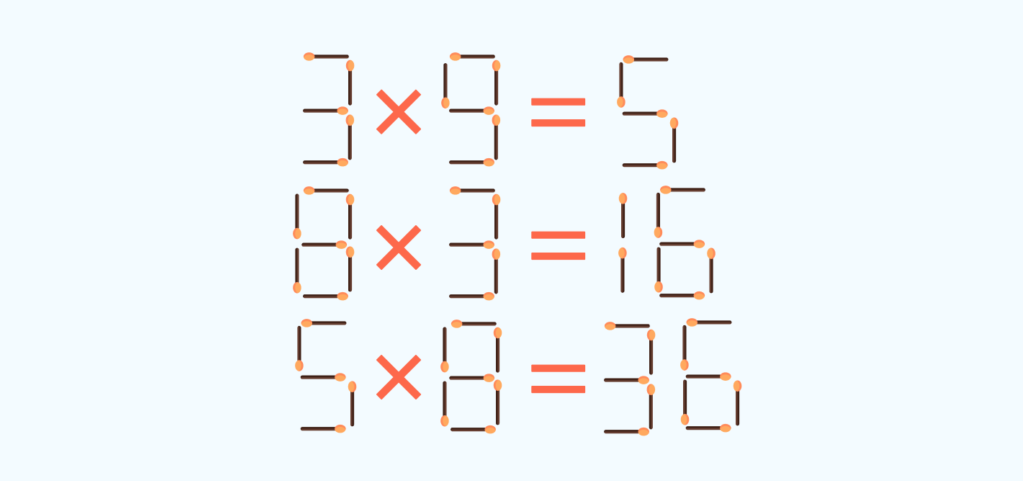
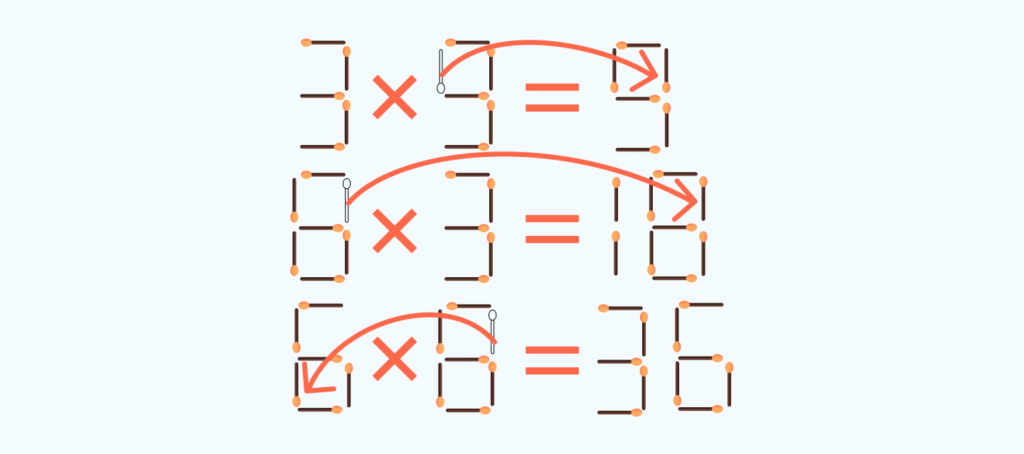
We can see that initially, all three equalities are incorrect.
If we look carefully at the numbers, we can see that if we move one match from the nine so that it turns out "3 x 3", and put it to the five on the right so that it becomes a nine, we get a correctly solved example: 3 x 3 = 9.
In the second case, the match should be taken from the eight and added to the number 6. It turns out: 6 x 3 = 18.
Well, in the third case, removing the match from the number 8 and attaching it to the five below, we get another fair equality: 6 x 6 = 36.
Puzzle #2
These equalities are slightly more complex as there are more terms here. The answer, as always, is not obvious at first sight.
In each example, move one match to get the correct equality.
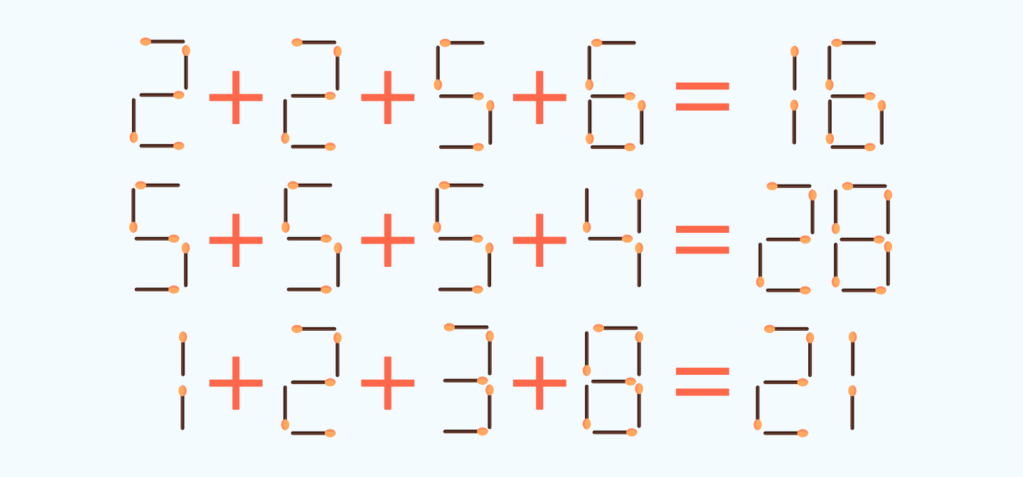
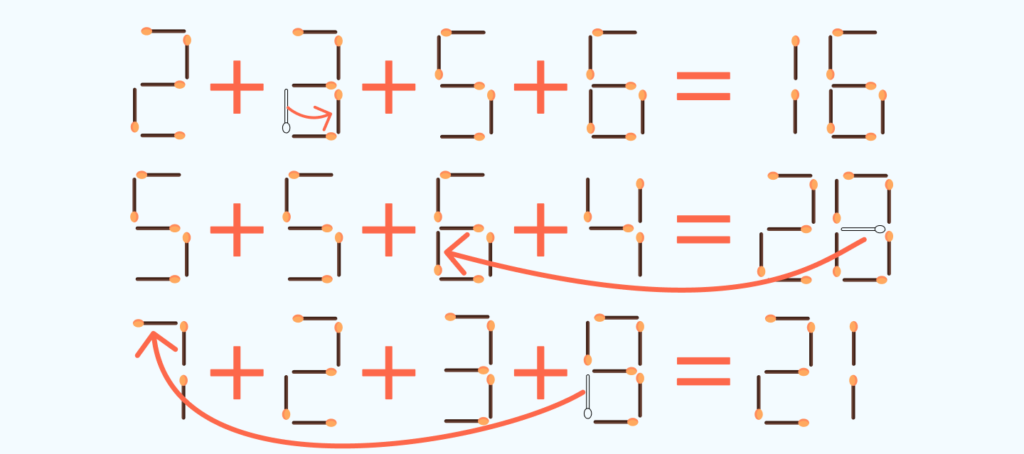
In the first case, shifting the match in the second two so that it becomes a three, we can see: 2 + 3 + 5 + 6 = 16.
In the second inequality, in order to turn it into equality, you need to turn 28 into 20 by removing the match from the number 8 and adding it to one of the fives.
To solve the third puzzle, we should turn one into a seven and an eight into a nine (by removing the stick from the bottom).
Puzzle #3
There can be variations with Roman numerals. The example is given below.
In each example, move only one match to get the correct equality.
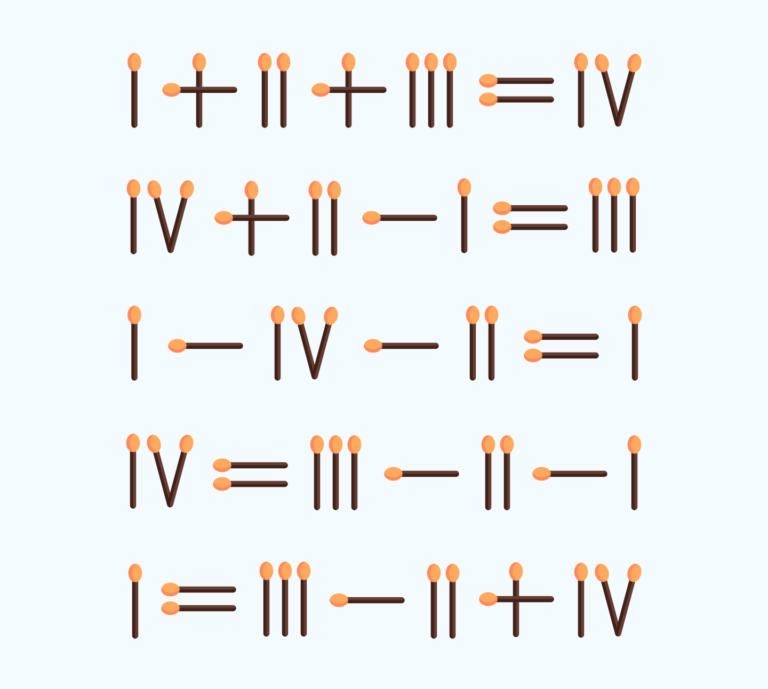
In the first example, everything is pretty easy: you just need to rearrange the match after the "=" sign that stands before V, so that it comes after it. Thus, instead of IV, we get VI.
In the second case, the equality will be true if you change the plus for minus and minus for plus, moving one match.
The third case solution is to remove the match from "=" and substitute it under a minus after I. The answer looks like that: I = ...
The fourth example with a rearranged match looks like this: IV - III = II - I (remove the match from the first equal sign and make a similar sign from the minus).
In the fifth example, the match must be "torn off" from a plus to make a plus from a minus: I = III + II-IV.
Puzzle #4
This type of puzzles suggests rearranging the matches to obtain a certain number of squares or triangles.
Move two matches to get five squares.


In this picture, two matches should be removed from the "roof" of the "house" to make a cross inside the square.
Puzzle #5
Move three matches to get eleven squares.

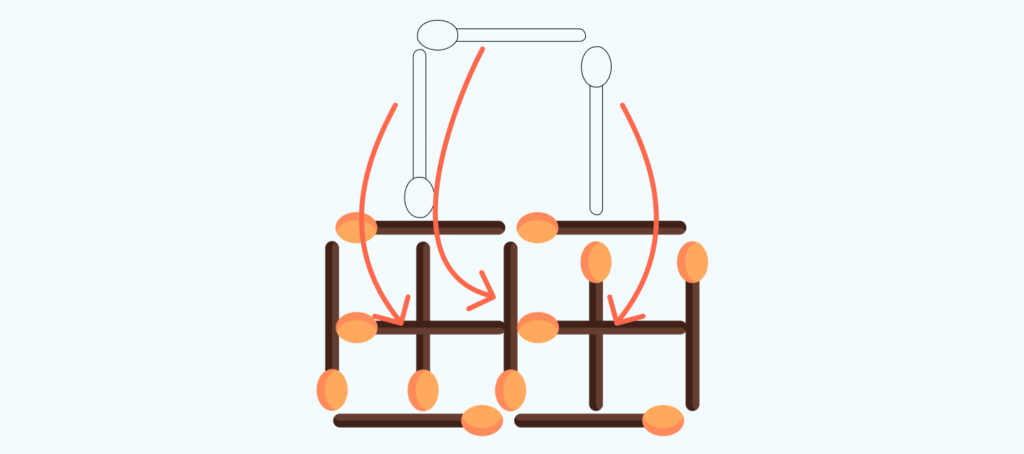
Here, we also remove the topside made of three matches and place them horizontally in one line inside the large rectangle.
Obviously, the more matches you have to move, the more difficult the task is, although the solution often looks simple.
Puzzle #6
Move six matches to get six equal diamonds.


You need to split all the triangles outside, removing the sides that are close to the center. Then you need to fill the inner space of the figure, putting the matches in the shape of a star from the center in different directions.
Puzzle #7
Sometimes the authors of matchstick puzzles let us remove the matches, not to move them from one place to another. Just as at the picture below:
Remove five matches to get five equal triangles.
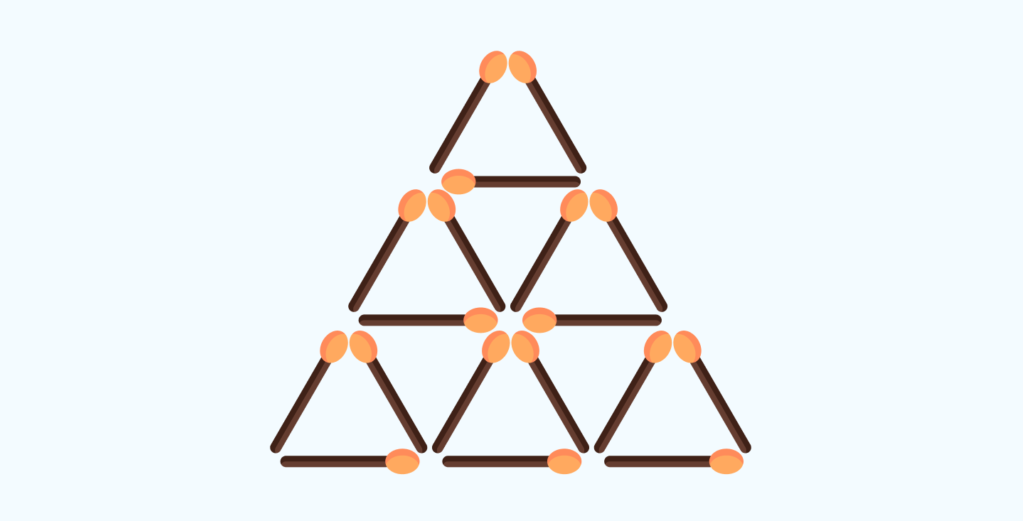

To get with this puzzle, you need to remove four matches in the first trapezoid from the top and the second match from the bottom row. There will be five identical triangles, which is what is required in the condition.
Puzzle #8
There are also more creative challenges. For example, this one: move two matches to make the animal in the picture look to the other side.
Move two matches to make the cow look to the right.


This is easy to do for this figure: you just need to turn the triangle of the head to the right.
Puzzle #9
For the following example, it is not as easy as for the previous example.
Move three matches to make the fish look to the right.


You need to move two matches from the left side and put the lower one in the center opposite them. Then put two matches, also one after another, through the row to the right, moving one row up. The third match, which is the single one, should be raised up in its own row. The task is complete: the fish has turned upside down.
Puzzle #10
One more version of the matchstick puzzle, in which you should determine by the figure’s shape from the side, which one corresponds to the top view.

In this case, it is easy to get confused as all the answers are very similar, with the only differences being in the directions of the matches, but at least nothing needs to be moved or rearranged.
If we "turn on" spatial thinking, we will get answer #5.

new engaging articles



